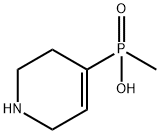TPMPA is a selective, competitive GABAC antagonist with only minimal effects on GABAA and GABAB receptor.
(1,2,5,6-Tetrahydropyridin-4-yl)methylphosphinic acid hydrate has also been used as γ-aminobutyric acid C (GABAc) blocker in retinal ganglion cells.
A selective, competitive GABA C antagonist with only minimal effects on GABA A and GABA B receptors (K b values are 2.1 μ M (antagonist), 320 μ M (antagonist) and EC 50 ~ 500 μ M (weak agonist) respectively). Displays 8-fold selectivity for human recombinant ρ 1 receptors over ρ 2 receptors.
TPMPA is a hybrid of isoguvacine and 3-APMPA designed to retain affinity for GABAC receptors but not to interact with GABAA or GABAB receptors. Electrical assays show that TPMPA is a competitive antagonist of cloned human mu 1 GABAC receptors expressed in Xenopus laevis oocytes (Kb approx. 2 μM). TPMPA is >100-fold weaker as an inhibitor of rat brain GABAA receptors expressed in oocytes (Kb approx. 320 μM) and has only weak agonist activity on GABAB receptors assayed in rat hippocampal slices (EC50 approx. 500 μM). TPMPA may be used to investigate GABAC receptor function in the outer retina and in any other areas of the nervous system in which these types of receptor are present.
